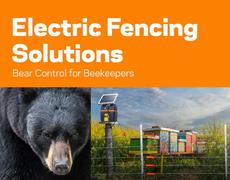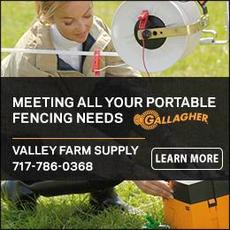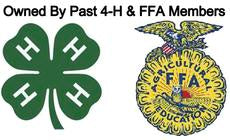|
From Roman Stoltzfoos of the Lancaster County Graziers
Dear Grazing Friends,
This letter informs you about two important opportunities. First is an opportunity to learn. Second, and more importantly, is an opportunity to help a farmer in distress. Spring Wood Farm will host another field day on July 12, 2018, where we will showcase two useful items: Redmond Salt and Conditioner, used for livestock feed and fertilizer on many grazing farms, and Shade Haven portable shade structures, used to more easily manage and reduce heat stress on livestock and preserve water quality during hot, sunny weather. These mobile shade structures are easily moved and can greatly reduce damage that is normal in shaded areas. This is of particular interest if you're in the Octorara Watershed, as the Chesapeake Bay Foundation is subsidizing these shade mobiles to the tune of 50% percent for those in the watershed. These are not chintzy, awkward, or hard-to-move shades. More information is available on both items. Agenda for July 12 Field Day:
- 9-11 a.m. - Tim Williams & Paul Horning - Presentation on Redmond Products
- 11 a.m. - Vince Hundt - Shade Haven Products - “What Are The Benefits of Shade for Livestock?”
- 11:30 a.m. - Leslie Weller - Chesapeake Bay Foundation • 11:30
- 1:30-3:30 p.m. - Colum Riley - “How Composting Can Benefit Farms and Communities”
On the test plot on Spring Wood Farm where we used the Redmond Salt and Conditioner blend in early spring, you will get to see the cows choosing the plot they prefer (treated or untreated). If it's a sunny day, you will also observe how cows enjoy the Shade Haven mobile shade structure. In Colum Riley’s talk on compost, “How Compost Can Help Improve Water Quality,” you’ll learn that while farmers & gardeners have long understood the importance of compost in soil fertility, modern science has just begun to scratch the surface and below when it comes to understanding the soil microbiome, and how it relates to the health of our water, air, animals and ourselves. Learn how compost aids in water conservation, flood mitigation and erosion control, while eliminating the need for harmful pesticides, excessive fertilizers and other practices which cause nutrient runoff. Carbon sequestration and reduction of methane emissions and on-farm diesel usage serve as additional benefits. And of course, healthy soils produce healthy foods which tackles yet another pressing public health issue. By incorporating on-farm composting and best-management practices to address local environmental concerns, dairy farmers in particular have a unique opportunity to act as catalysts for positive change in their communities and beyond. Should you consider making and using compost on your farm?
The opportunity to help
Rob and Pam Moore, long-time attendees and supporters at the Southeast PA Grazing Conference and 100% grass dairy farmers in New York, have experienced some real difficult times on the farm this spring. Viral bacterial pneumonia ripped through their herd of mature cows and springing heifers. The losses were heavy to mortality, but many more needed preventative antibiotic treatment and were disqualified for Organic production. If you are a dairy farmer, you can only imagine the painful consequences and losses this incurred. Some of us are banding together to give them cows and heifers. As of this writing, we are sending some cows north and are asking any 100% grass dairy farmers if they would be willing to help as well. Even cows that are not 100% grass-fed but are organic could be used as nurse cows for the calves. Those of you that would like to help but do not have the qualifying cows can do so by directing your cash donation to Lancaster County Graziers, earmarked the Rob Moore Cow Replacement Fund. Cash donations will be used for collecting and trucking the cattle and making up for lost milk production. At the field day we will give you an update on the needs. Please, the need to donate is urgent. Contact Levi Fisher (717-405-9438) or Forest Stricker (484-529-5886) for details and to arrange truckers. Cows need a very simple vaccination before shipping, if possible. Our goal is to raise at least $5,000 for shipping to get them 20-40 cows. All proceeds over expenses will go to Moore’s Cow Replacement Fund.
This Field Day will be a fundraiser. You will be preregistered for the event with a donation of any amount. We will ask for a donation of $50 or more at the door. Please bring a food item to share for lunch. Volunteers to coordinate the lunch would be really helpful. Text or call Roman at 717-278-1070 about your offer for food or help to set up and serve lunch.
Please consider joining us for this opportunity to learn and to help the Rob Moore Farm Family. You need not be an attendee at this Field Day to help the Moore Family. Our vision for the grazing groups is to not only educate but also help each other in situations like this. Vendor participation is appreciated. Your donation to the fund will be your choice.
This will be a completely free seminar/pasture walk (suggested donation $10-50 per person) with lots of learning opportunities. You do not need to register for this event. It would be helpful if you would call 610-593-2415 and leave a message or text 717-278-1070 with a name and number attending, so we can plan for seating and tables to serve food. Please bring something to share for lunch. It will be a true potluck. We’d all love to sample your cheese or other homemade goodies, whatever they are. We will provide the drinks and have tableware on hand.
Sincerely,
Roman Stoltzfoos
Secretary, Lancaster County Graziers
|




 For example, a bird sitting on the wire will not receive a shock (shown left). It is not touching the ground so the circuit is not completed. A person wearing insulated footwear will only receive a small shock because all the current cannot pass through the insulated soles.
For example, a bird sitting on the wire will not receive a shock (shown left). It is not touching the ground so the circuit is not completed. A person wearing insulated footwear will only receive a small shock because all the current cannot pass through the insulated soles.






